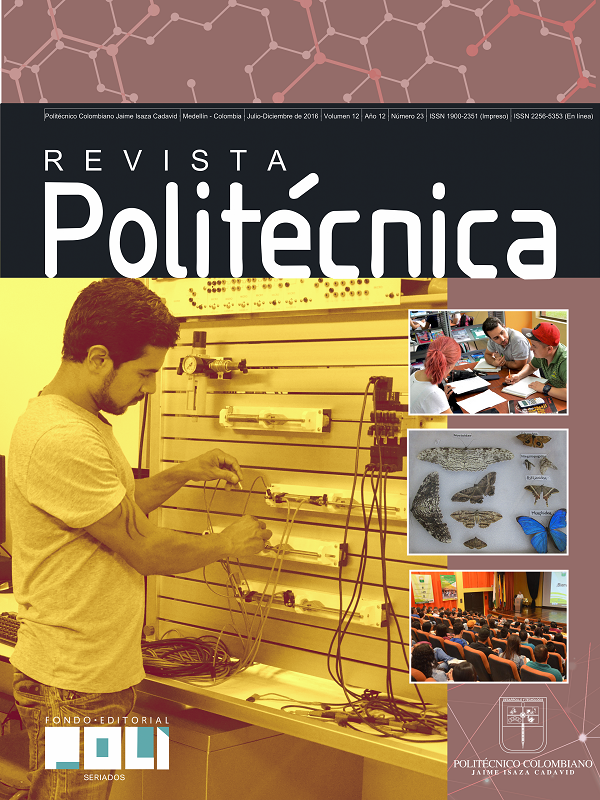Implementación de un control no lineal para el seguimiento robot-humano con un sensor 3D
Palabras clave:
seguimiento de esqueletos, sensor kinect®, robot seguidor de un humano, control no-linealResumen
En la actualidad más personas adultas requieren de dispositivos mecatrónicos que faciliten y ayuden en sus actividades diarias. Los robots móviles se convirtieron en una buena alternativa debido a que actualmente la tecnología, permite que puedan reconocer y realizar el seguimiento de una persona. En este trabajo, se emplea la plataforma robótica Pionner 3-AT® y un sensor de profundidad Kinect® para realizar el seguimiento de una persona. Secuencias de imágenes de profundidad y un algoritmo de reconocimiento de esqueletos, suministrados por el Kinect®, permite conocer y estimar las coordenadas y velocidad de una persona, que al ser introducidas al control no lineal basado en linealización por realimentación, genera los comandos de velocidad lineal y angular que hacen que el robot mantenga una orientación y distancia deseadas a la persona. Finalmente, se presenta y discute los resultados obtenidos después de realizar la validación del algoritmo con una serie de pruebas experimentales.
Métricas de artículo
Resumen: 534 HTML: 106 PDF: 247 XML: 37Citas
Ortman, J. M., Velkoff, V. A., y Hogan, H. An aging nation: the older population in the United States., DC: US Census Bureau., 25-1140, 2014.
United Nations. World Population Ageing 2015. WPA2015. New York. Department of Economic and Social Affairs Population Division., 2015.
Broekens, J., Heerink, M., y Rosendal, H. Assistive social robots in elderly care: a review. Gerontechnology., 8, 94-103, 2009.
Dahl, T. S., y Boulos, M. N. K. Robots in Health and Social Care: A Complementary Technology to Home Care and Telehealthcare?. Robotics., 3, 1-21, 2013.
Beech, R., y Roberts, D. Assistive technology and older people. London: SCIE., 2008.
Allen, K., y Glasby, J. ‘The Billion Dollar Question’: Embedding Prevention in Older People's Services—Ten ‘High-Impact’Changes. British Journal of Social Work, bcs024., 2012.
Cao, M., y Hashimoto, H. Specific person recognition and tracking of mobile robot with Kinect 3D sensor. In Industrial Electronics Society, IECON 2013-39th Annual Conference of the IEEE., 8323-8328, 2013.
Hoshino, F., y Morioka, K. Human following robot based on control of particle distribution with integrated range sensors. In System Integration (SII), 2011 IEEE/SICE International Symposium on., 212-217, 2011.
Wengefeld, T., Eisenbach, M., Trinh, T. Q., y Gross, H. M. May I be your Personal Coach? Bringing Together Person Tracking and Visual Reidentification on a Mobile Robot. In ISR 2016: 47st International Symposium on Robotics; Proceedings of.,1-8, 2016.
Doisy, G., Jevtic, A., Lucet, E., y Edan, Y. Adaptive person-following algorithm based on depth images and mapping. In Proc. of the IROS Workshop on Robot Motion Planning., 2012.
Xing, G., Tian, S., Sun, H., Liu, W., y Liu, H. People-following system design for mobile robots using Kinect sensor. In 2013 25th Chinese Control and Decision Conference (CCDC)., 3190-3194, 2013.
Chu, H. C., Chien, M. F., Lin, T. H., y Zhang, Z. J. Design and implementation of an auto-following robot-car system for the elderly. In System Science and Engineering (ICSSE), 2016 International Conference on.,1-4, 2016.
Soria, c., Carelli, R., Kelly, R., y Ibarra Zannatha, J. Control de robots cooperativos por medio de visión artificial. XVI congreso de la asociación chilena de control automático. 2004.


 _
_


















